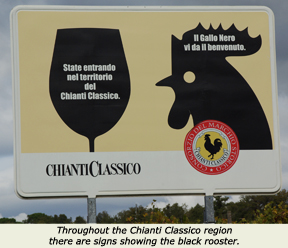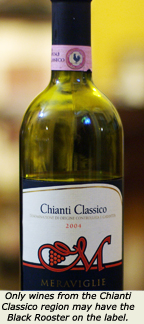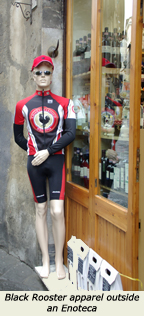The Legend of the Black Rooster
by Terry Sullivan
When traveling the Chianti Classico countryside one notices signs featuring a black rooster. The black rooster is also seen on seals of some wine bottles and on merchandise probably aimed at tourists. Why use a black rooster symbol for a logo?
 The Chianti Classico area lies between Florence to the north and Siena to the south. Since about the year 1000 A.D., people living within the Tuscany borders as well as beyond the border enjoyed red wine produced from this area. The legend of the black rooster goes back to a time when the cities of Florence and Siena fought over the area that is now the Chianti Classico zone. Both cities wanted to claim Chianti Classico as their own. The dispute waged on for years and in the early 1200’s the leaders decided to settle the issue by a competition.
The Chianti Classico area lies between Florence to the north and Siena to the south. Since about the year 1000 A.D., people living within the Tuscany borders as well as beyond the border enjoyed red wine produced from this area. The legend of the black rooster goes back to a time when the cities of Florence and Siena fought over the area that is now the Chianti Classico zone. Both cities wanted to claim Chianti Classico as their own. The dispute waged on for years and in the early 1200’s the leaders decided to settle the issue by a competition.
Two horsemen were to set out at the crow of a cock. One equestrian from Florence and one from Siena would meet along the road connecting the two cities. The Sienese chose a well-fed white rooster as their official timekeeper, while the Florentines chose a starving black rooster for their timekeeper. On the day of the event, the black rooster began to crow early long before sunrise and the Florentine rider set off towards Siena. Meanwhile the Sienese white rooster took its time and began to crow at sunrise. As a result, the Florentine rider was able to cover more ground and met the Sienese rider just 19 kilometers north of Siena. The boundary lines were drawn at the meeting spot and the majority of Chianti Classico region now fell under the jurisdiction of Florence.
Whether or not the legend is true, the image of a black rooster on a gold background is 700 years old. The black rooster was branded in 1384 as the emblem for the League of Chianti. Today, the Black Rooster label is placed on the neck of a bottle of wine from the Chianti Classico zone. If the seal on the bottle has a red border around a black rooster, the wine is a young Chianti Classico meant to be enjoyed now. A gold border represents a Chianti Classico Reserva that can age for many years.

 Not all wine from Chianti will bear the black rooster. The Chianti region became a DOC in 1967 and a DOCG in 1984. The Chianti Classico zone was considered a sub-appellation until 1996 when it became a DOCG appellation. In 2006, the regulations regarding wine with the DOCG on the label were revised. In the new regulations, a minimum of 80% of the wine has to be Sangiovese. There may be 100% Sangiovese or the wine maker may substitute another red grape or grapes but may not exceed 20%. Wine makers are no longer permitted to blend white grapes in their Chianti Classico wines beginning with the 2006 vintage. The minimum alcohol was set at 12% for the regular and 12.5% for the Reserva. Other rules also dictate if a wine can be called Chianti Classico. For example, there is a limit of 3.34 tons of grapes per acre. The regular wine may not be released until October 1 of the year following the harvest. The Riserva may not be released until after 24 months with at least three months of aging in the bottle.
Not all wine from Chianti will bear the black rooster. The Chianti region became a DOC in 1967 and a DOCG in 1984. The Chianti Classico zone was considered a sub-appellation until 1996 when it became a DOCG appellation. In 2006, the regulations regarding wine with the DOCG on the label were revised. In the new regulations, a minimum of 80% of the wine has to be Sangiovese. There may be 100% Sangiovese or the wine maker may substitute another red grape or grapes but may not exceed 20%. Wine makers are no longer permitted to blend white grapes in their Chianti Classico wines beginning with the 2006 vintage. The minimum alcohol was set at 12% for the regular and 12.5% for the Reserva. Other rules also dictate if a wine can be called Chianti Classico. For example, there is a limit of 3.34 tons of grapes per acre. The regular wine may not be released until October 1 of the year following the harvest. The Riserva may not be released until after 24 months with at least three months of aging in the bottle.
The next time you purchase a bottle of Chianti Classico, look to see if the DOCG is on the label. Also, look at the neck of the bottle to see the emblem of the black rooster.
